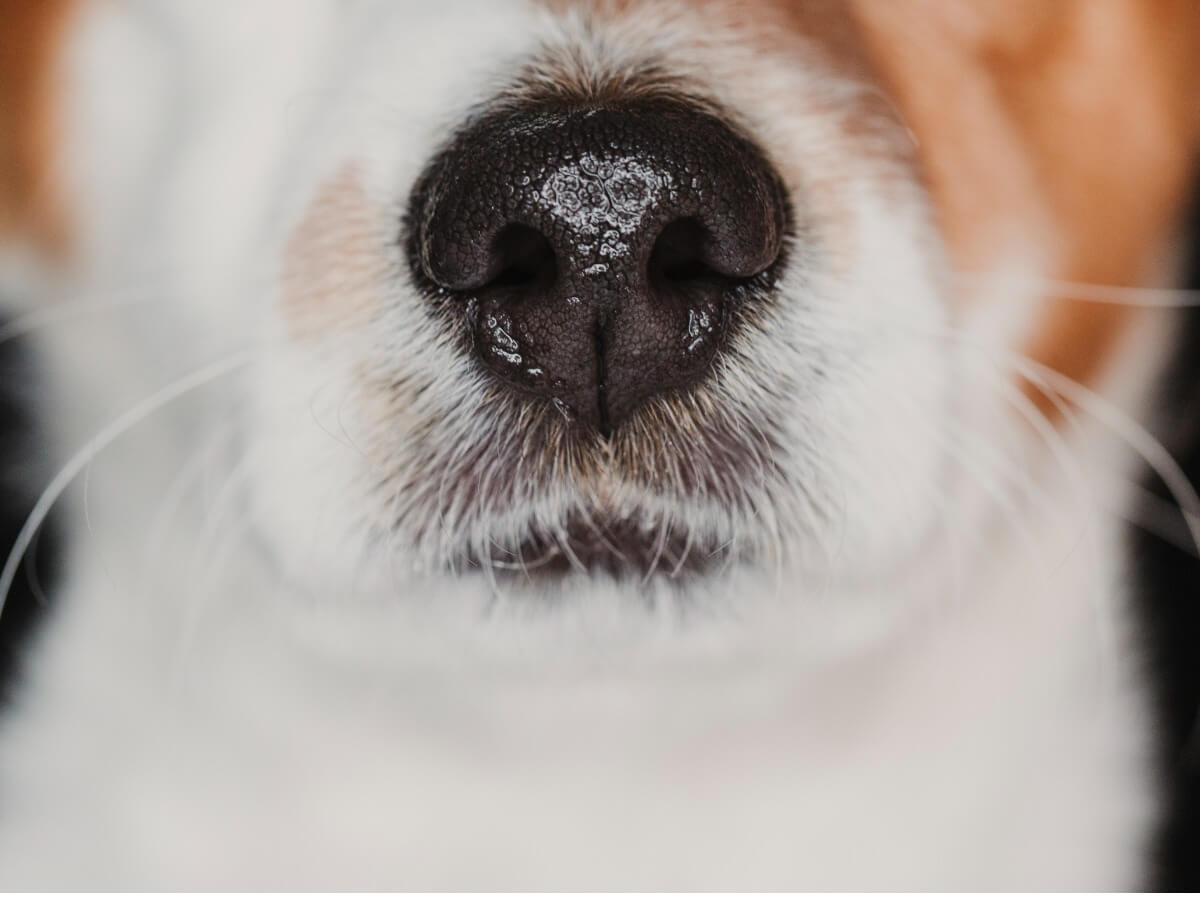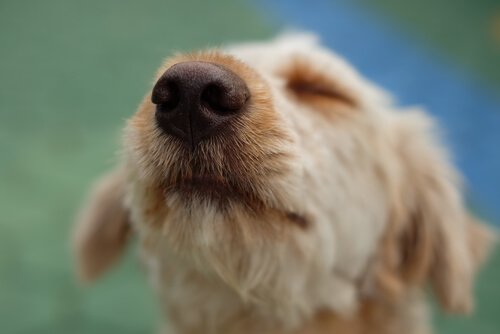Smells that Dogs Can't Stand


Written and verified by the psychologist Sara González Juárez
Even if your dog seems to have a taste for the most bizarre smells from a human point of view (such as feces), there are still some smells that dogs can’t stand. And this is something to keep in mind, as their sense of smell is a thousand times more acute than ours.
This is why you’ll find here several examples of the smells dogs can’t stand, as most of them can be found in any house. If you want to protect your dog, here’s everything you need to know.
The sense of smell in dogs
Smell is the sense that allows us to recognize which molecules are floating in the air. Dogs (and any animal with this sense) have receptive cells to these molecules spread throughout the nasal cavity. From the nasal mucosa, the nerves travel to the brain, where these stimuli are processed in the olfactory lobe.
Dogs have 220 million olfactory receptors in their nose and humans have only 5 million.
To this basic pathway of smell recognition we must mention the vomeronasal organ, a small cavity located in the upper part of the palate that has its own type of odor-receptive cells. It specializes in the olfactory chemical signals that the dog receives from other animals, which are used for communication. For example, information about the sexual disposition of females is obtained through the vomeronasal.

Smells that dogs can’t stand
In general, strong chemical smells are the most unpleasant ones for our canine friends. Here are some examples of those most common in homes.
Citrus
It’s unusual for a dog to be attracted to the smell of a lemon or the peel of a tangerine. This is due to survival issues, as it isn’t good for dogs to consume very acidic foods that could damage their stomach mucosa. On the other hand, these fruits contain a high amount of sugar which is also detrimental to the dog’s long-term health due to the risk of diabetes and obesity.
It’s important not to use citrus essential oils near them, as they’re highly concentrated and could damage the dog’s nasal mucosa.
Chemicals
Cleaning products, loaded with powerful chemicals to disinfect the home, are mostly harmless when a small part is diluted in water for washing up. However, inside their packaging they’re still concentrated, making them very aggressive to canines.
It’s essential that they don’t have access to the places where you store them, and not because of the risk of their ingestion (as we’ve said, the smell repels them). Bleach, ammonia, and other products are capable of irritating the animal’s respiratory tract, so always keep them in a safe place.
Spicy food smells
Humans enjoy spicy food, but most animals don’t. It actually activates nociceptors (the cells specialized in the sensation of pain), an experience that dogs don’t like at all. Spiciness causes irritation of the mucous membranes, both nasal and oral, so they avoid it as soon as they detect it.
Never use these substances to repel your dog or punish them, as it’s very unpleasant and can even hurt them.
Vinegar
Dogs don’t like vinegar either. For humans, it’s a bearable smell, and we use it for cleaning and in different recipes and home remedies. For dogs, this sour smell is much stronger, so don’t be surprised if they shy away from your salads when you dress them with vinegar.
However, when you dilute it to repel them, it’s harmless, and you can use it in areas where you don’t want them to urinate, for example.
Alcohol
This is another smell that dogs can’t stand due to its irritating potential. As it’s a characteristic and very strong aroma, dogs avoid it whenever they can. It’s also a common ingredient in cosmetics and other self-care products, as well as perfumes and air fresheners. Avoid using too much of it and, of course, never leave it within reach of your dog’s nose.
Smells that dogs can’t stand, an intuitive question

Of course, you need to know all the substances that could intoxicate or harm your dog. However, when faced with new smells, it’s enough to carefully observe the animal’s reaction, as this will give clear signs that it can’t stand a particular odor. Sneezing, coughing, and even not entering certain rooms are clear signs that their great sense of smell is playing a trick on them.
Make sure you look after your dog’s nose, because it’s difficult for us to imagine its enormous complexity and precision. Did you know all these smells that dogs can’t stand?
Even if your dog seems to have a taste for the most bizarre smells from a human point of view (such as feces), there are still some smells that dogs can’t stand. And this is something to keep in mind, as their sense of smell is a thousand times more acute than ours.
This is why you’ll find here several examples of the smells dogs can’t stand, as most of them can be found in any house. If you want to protect your dog, here’s everything you need to know.
The sense of smell in dogs
Smell is the sense that allows us to recognize which molecules are floating in the air. Dogs (and any animal with this sense) have receptive cells to these molecules spread throughout the nasal cavity. From the nasal mucosa, the nerves travel to the brain, where these stimuli are processed in the olfactory lobe.
Dogs have 220 million olfactory receptors in their nose and humans have only 5 million.
To this basic pathway of smell recognition we must mention the vomeronasal organ, a small cavity located in the upper part of the palate that has its own type of odor-receptive cells. It specializes in the olfactory chemical signals that the dog receives from other animals, which are used for communication. For example, information about the sexual disposition of females is obtained through the vomeronasal.

Smells that dogs can’t stand
In general, strong chemical smells are the most unpleasant ones for our canine friends. Here are some examples of those most common in homes.
Citrus
It’s unusual for a dog to be attracted to the smell of a lemon or the peel of a tangerine. This is due to survival issues, as it isn’t good for dogs to consume very acidic foods that could damage their stomach mucosa. On the other hand, these fruits contain a high amount of sugar which is also detrimental to the dog’s long-term health due to the risk of diabetes and obesity.
It’s important not to use citrus essential oils near them, as they’re highly concentrated and could damage the dog’s nasal mucosa.
Chemicals
Cleaning products, loaded with powerful chemicals to disinfect the home, are mostly harmless when a small part is diluted in water for washing up. However, inside their packaging they’re still concentrated, making them very aggressive to canines.
It’s essential that they don’t have access to the places where you store them, and not because of the risk of their ingestion (as we’ve said, the smell repels them). Bleach, ammonia, and other products are capable of irritating the animal’s respiratory tract, so always keep them in a safe place.
Spicy food smells
Humans enjoy spicy food, but most animals don’t. It actually activates nociceptors (the cells specialized in the sensation of pain), an experience that dogs don’t like at all. Spiciness causes irritation of the mucous membranes, both nasal and oral, so they avoid it as soon as they detect it.
Never use these substances to repel your dog or punish them, as it’s very unpleasant and can even hurt them.
Vinegar
Dogs don’t like vinegar either. For humans, it’s a bearable smell, and we use it for cleaning and in different recipes and home remedies. For dogs, this sour smell is much stronger, so don’t be surprised if they shy away from your salads when you dress them with vinegar.
However, when you dilute it to repel them, it’s harmless, and you can use it in areas where you don’t want them to urinate, for example.
Alcohol
This is another smell that dogs can’t stand due to its irritating potential. As it’s a characteristic and very strong aroma, dogs avoid it whenever they can. It’s also a common ingredient in cosmetics and other self-care products, as well as perfumes and air fresheners. Avoid using too much of it and, of course, never leave it within reach of your dog’s nose.
Smells that dogs can’t stand, an intuitive question

Of course, you need to know all the substances that could intoxicate or harm your dog. However, when faced with new smells, it’s enough to carefully observe the animal’s reaction, as this will give clear signs that it can’t stand a particular odor. Sneezing, coughing, and even not entering certain rooms are clear signs that their great sense of smell is playing a trick on them.
Make sure you look after your dog’s nose, because it’s difficult for us to imagine its enormous complexity and precision. Did you know all these smells that dogs can’t stand?
All cited sources were thoroughly reviewed by our team to ensure their quality, reliability, currency, and validity. The bibliography of this article was considered reliable and of academic or scientific accuracy.
- Coli, A., Stornelli, MR y Giannessi, E. (2016). El órgano vomeronasal del perro: una revisión. Comportamiento canino , 2 (1), 24-31.
- Caso, LP (2023). El perro: su comportamiento, nutrición y salud. John Wiley & Sons.
- Wernimont, S. M., Radosevich, J., Jackson, M. I., Ephraim, E., Badri, D. V., MacLeay, J. M., … & Suchodolski, J. S. (2020). The effects of nutrition on the gastrointestinal microbiome of cats and dogs: impact on health and disease. Frontiers in Microbiology, 11, 1266.
This text is provided for informational purposes only and does not replace consultation with a professional. If in doubt, consult your specialist.








